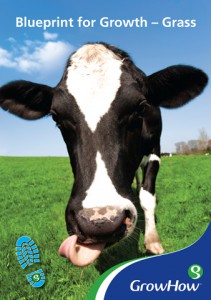- August 20th, 2011
- /
- Grass and forage seed, Grassland management
- /
- 0 Comments
- /
- GrowHow introduces new blueprint for grass growth

 Deciding which fertilisers fit best into your livestock management system is now a little easier with the introduction by GrowHow UK of a new booklet. Called the Blueprint for Growth – Grass, it was launched at the Dairy Event on September 6.
Deciding which fertilisers fit best into your livestock management system is now a little easier with the introduction by GrowHow UK of a new booklet. Called the Blueprint for Growth – Grass, it was launched at the Dairy Event on September 6.
“In essence, Blueprint for Growth is about looking carefully at the fertiliser options on an individual farm basis,” explains GrowHow Grassland Specialist, Elaine Jewkes. “Action plans can then be developed to take into account the specific requirements of the management system.”
The new Blueprint for Growth – Grass booklet outlines the principles of good grassland and forage nutrition and provides working examples of how different systems can make best use of fertilisers, together with manures. It demonstrates that avoiding ‘a one size fits all approach’ to fertiliser recommendations makes sense, especially with global demand keeping fertiliser prices high.
“There is little point in applying fertiliser to grow forage that you don’t need,” says Elaine. “However where fertilisers are used effectively, the old rule of thumb that £1 spent on grassland fertiliser delivers £3 of feed value still holds good.”
Whatever the production system, a well-managed sward will make a vital and cost-effective contribution to milk or meat production. Elaine continues: “If you read any of the livestock press you will regularly see evidence that grass, and particularly grazed grass, is the cheapest feed on the farm. However, it is easy to forget that grass is also a quality feed that helps many dairy farmers to achieve 4,000 litres plus from forage.”
The key to a quality sward is to provide all the nutrients the grass needs. But this must be done carefully, taking into account not just costs but also legal requirements and the environment in general. As the NVZ N Max for grass falls to 300 kg N/ha in 2012, now is a good time to review fertiliser plans. Fertilisers should be used to balance the nutrients in applied manures but with a little planning this is not too difficult to achieve.
What’s more with customers increasingly asking their suppliers to make environmental improvements, it’s good to know that all GrowHow Nitrogen fertilisers now come with a much smaller carbon footprint. This is the result of significant investment in nitrous oxide abatement technology which has seen annual emissions reduced by around one million tonnes of CO2 equivalent.

